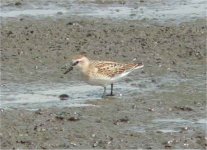eteune
ET
got some nice shorebirds migrating through Chicago area now.
This little guy seems brownish to be a Least, but the dark line in front of his eye, the white supercilium and lighter breast seem to point to Semipalmated, any ideas?
Oh, BTW, all the birds legs were covered in mud this day.
thanks,
Ed
This little guy seems brownish to be a Least, but the dark line in front of his eye, the white supercilium and lighter breast seem to point to Semipalmated, any ideas?
Oh, BTW, all the birds legs were covered in mud this day.
thanks,
Ed




